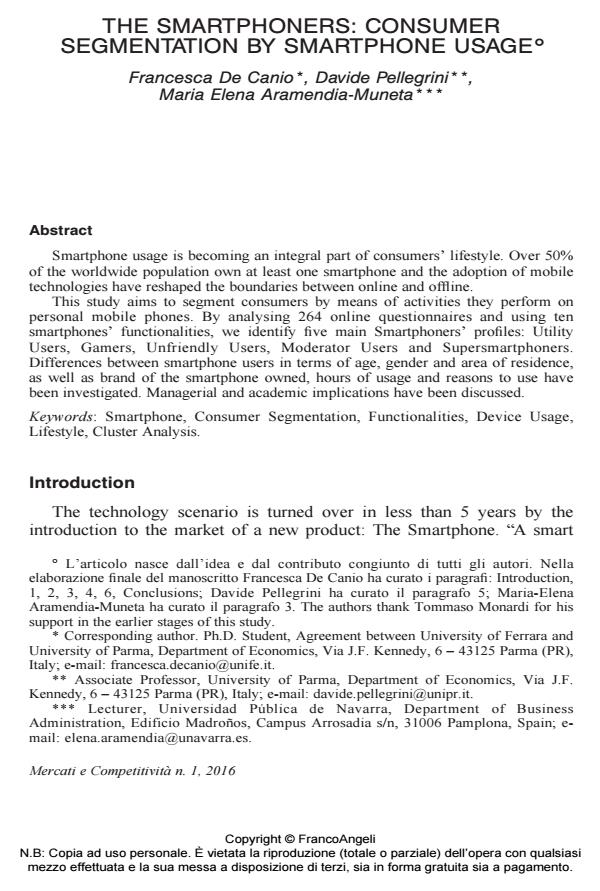The smartphoners: consumer segmentation by smartphone usage
Titolo Rivista MERCATI E COMPETITIVITÀ
Autori/Curatori Francesca De Canio, Davide Pellegrini, Maria Elena Aramendia-Muneta
Anno di pubblicazione 2016 Fascicolo 2016/1
Lingua Inglese Numero pagine 22 P. 123-144 Dimensione file 135 KB
DOI 10.3280/MC2016-001007
Il DOI è il codice a barre della proprietà intellettuale: per saperne di più
clicca qui
Qui sotto puoi vedere in anteprima la prima pagina di questo articolo.
Se questo articolo ti interessa, lo puoi acquistare (e scaricare in formato pdf) seguendo le facili indicazioni per acquistare il download credit. Acquista Download Credits per scaricare questo Articolo in formato PDF

FrancoAngeli è membro della Publishers International Linking Association, Inc (PILA)associazione indipendente e non profit per facilitare (attraverso i servizi tecnologici implementati da CrossRef.org) l’accesso degli studiosi ai contenuti digitali nelle pubblicazioni professionali e scientifiche
Smartphone usage is becoming an integral part of consumers’ lifestyle. Over 50% of the worldwide population own at least one smartphone and the adoption of mobile technologies have reshaped the boundaries between online and offline. This study aims to segment consumers by means of activities they perform on personal mobile phones. By analysing 264 online questionnaires and using ten smartphones’ functionalities, we identify five main Smartphoners’ profiles: Utility Users, Gamers, Unfriendly Users, Moderator Users and Supersmartphoners. Differences between smartphone users in terms of age, gender and area of residence, as well as brand of the smartphone owned, hours of usage and reasons to use have been investigated. Managerial and academic implications have been discussed.
Parole chiave:Smartphone, Consumer Segmentation, Functionalities, Device Usage, Lifestyle, Cluster Analysis
- The second-level smartphone divide: A typology of smartphone use based on frequency of use, skills, and types of activities Alexander Wenz, Florian Keusch, in Mobile Media & Communication /2023 pp.459
DOI: 10.1177/20501579221140761 - Green Products in the Fashion Industry: Consumer Segmentation to Develop Communication Campaigns Laura Martinez-Huete, Maria Elena Aramendia-Muneta, in Fashion Practice /2025 pp.105
DOI: 10.1080/17569370.2024.2426647 - Differences in the perceived financial risk factors between digital natives in the e-commerce Richard Fedorko, Veronika Skerhakova, Stela Markova, Radovan Bacík, Lubomir Fejercak, in Marketing and Management of Innovations /2021 pp.137
DOI: 10.21272/mmi.2021.4-11 - Occupational and Environmental Safety and Health VI Ljupcho Efremov, Elsa Abboud, pp.255 (ISBN:978-3-031-82290-2)
Francesca De Canio, Davide Pellegrini, Maria Elena Aramendia-Muneta, The smartphoners: consumer segmentation by smartphone usage in "MERCATI E COMPETITIVITÀ" 1/2016, pp 123-144, DOI: 10.3280/MC2016-001007